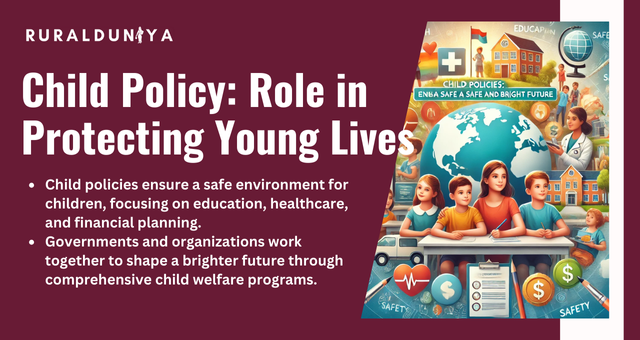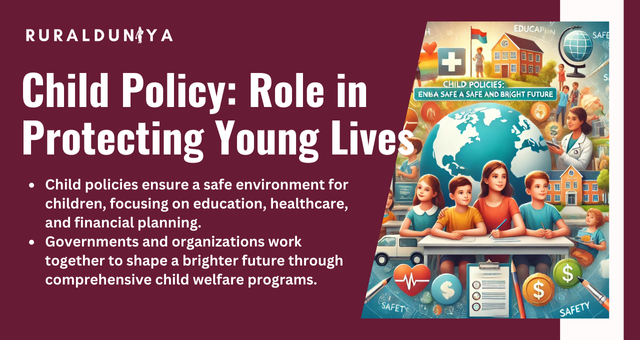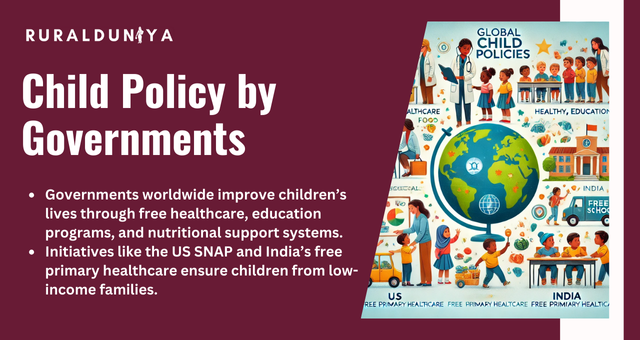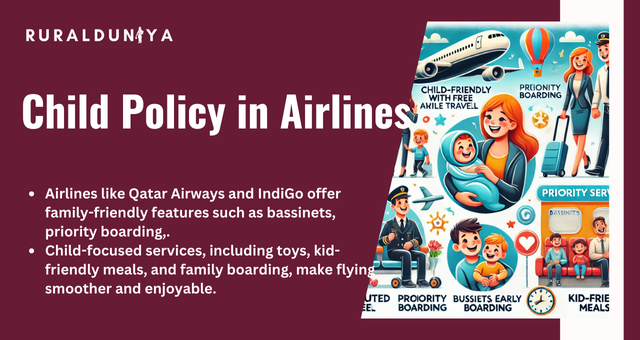Child policy around the world are created to protect and nurture children, ensuring their health, education, and overall well-being. These policies differ based on the cultural, social, and economic context of each country or organization.
Child Policy: Role in Protecting Young Lives

A child policy is a set of rules or guidelines that aim to ensure the safety, health, and development of children. These policies can cover areas like healthcare, education, safety, and financial planning.
Governments, organizations, and industries often implement child policies to meet the changing needs of society and improve the quality of life for children. Whether by governments or private institutions, child policies play a crucial role in shaping a better future for children.
Child Policy Acts
The acts provide the legal framework for protecting children’s rights. One key example is the United Nations Convention on the Rights of the Child (UNCRC), which offers comprehensive guidelines for child welfare worldwide.
At a national level, many countries have laws to address issues such as child labor, abuse, and neglect. For example, India’s Juvenile Justice Act and the Protection of Children from Sexual Offences (POCSO) Act are important for child safety.
Inspired by UNCRC, several countries have improved access to education for children.
Child Policy in India
India’s policies aim to safeguard children’s education, health, and safety. The Right to Education Act ensures free schooling for children aged 6 to 14, while programs like the Mid-Day Meal Scheme provide free meals to improve attendance and nutrition.
Another example is Beti Bachao Beti Padhao, which focuses on empowering and educating girls. The Integrated Child Development Services (ICDS) program provides early childhood care and nutrition support, especially in rural areas.
Child Policy in China
China’s child policies are shaped by its demographic strategies. The one-child policy, introduced in 1979, controlled population growth but also caused social and family changes. In 2015, this was eased to allow two children, and in 2021, three children were permitted.
Recent policies focus on healthcare, education, and family support. For example, urban areas now provide free healthcare for children under six, reflecting a shift toward supporting larger families.
Child Policy in Japan

Japan’s child policies address its aging population and declining birth rate. The government offers financial incentives, like the Kodomo Teate (Child Allowance), to families with children under 15.
Subsidized childcare services and extended parental leave are also provided to encourage people to have more children.
Early childhood education programs help ensure children are well-prepared for the future, making Japan’s child policies a model for addressing demographic challenges.
National Child Policy in Zambia
Zambia’s National Policy focuses on reducing child poverty, malnutrition, and mortality.
The 2015 policy ensures children have access to healthcare and education while addressing child labor issues. Programs like the Home Grown School Feeding Programme aim to improve nutrition and school attendance by providing meals sourced from local farmers.
Child Policy in LIC
In India, Life Insurance Corporation (LIC) offers financial policies to secure a child’s future. Plans such as LIC’s New Children’s Money Back Policy and LIC Jeevan Tarun provide payouts at key milestones like education or marriage.
These plans also offer financial protection if the policyholder passes away. Such policies are an excellent way for families to plan ahead and ensure financial stability for their children.
Child Policy Plans
The plans are offered by insurance companies to help parents secure their child’s future. These plans can cover education, marriage, or other major expenses. For example, HDFC Life’s YoungStar Super Premium plan supports higher education by offering flexible payouts.
Many plans also include features like premium waivers if the parent dies, ensuring the child’s financial needs are still met.
Child Policy by Governments

Governments worldwide introduce child policies to improve the quality of life for children. These include free healthcare, education programs, and nutritional support.
For instance, the US Supplemental Nutrition Assistance Program (SNAP) ensures children from low-income families have access to healthy food. In India, free primary healthcare services for children in government hospitals are a common feature.
Child Policy in Hotels
Hotels often have specific policies for children to make stays comfortable for families. These can include free stays for young children, discounted meals, and kid-friendly activities. For example, Hyatt hotels run a “Kids Eat Free” program during certain seasons.
These policies enhance family travel experiences, making it easier for parents to vacation with their children.
Child Policy for Central Government Employees
In India, central government employees benefit from policies tailored to help them manage work and family. Employees are entitled to childcare leave, medical allowances for children, and scholarships for their education.
Women employees, for instance, can take up to 730 days of childcare leave to focus on their child’s upbringing.
Child Policy in Post Offices
Post offices in India offer financial schemes like the Sukanya Samriddhi Yojana to secure the future of children, especially girls. These schemes come with attractive interest rates and tax benefits.
Another option is recurring deposit accounts, which help parents save for their child’s education or marriage. Sukanya Samriddhi Yojana is particularly effective for parents planning long-term savings for their daughters.
Child Policy in Airlines

Airlines have guidelines for traveling with children, including ticket fares, safety measures, and in-flight services.
- Child Policy in Flight
Airlines often allow infants to travel for free or at a discounted rate when seated on an adult’s lap. Safety features like extra oxygen masks and bassinets are provided. Emirates, for example, offers toys and special meals for kids.
- Child Policy in IndiGo
IndiGo Airlines allows infants (up to 2 years old) to travel for a small fee. Families get priority boarding, and front-row seats can be reserved for convenience. This policy ensures smooth travel for parents with young children.
- Child Policy in Qatar Airways
Qatar Airways provides bassinets, kid-friendly meals, and entertainment. Children traveling alone are supported by dedicated staff. Families are given toys and activity kits to keep young travelers engaged.
- Child Policy in Southwest Airlines
Southwest Airlines offers free check-in for baby items like strollers. Family boarding is available for parents with kids under six, ensuring they can sit together. Their EarlyBird Check-In service is especially helpful for securing seats together during busy flights.
Child Policy Calculator
The calculators help parents estimate premiums, benefits, and maturity amounts for various plans. These tools simplify comparisons and guide families in making better financial decisions. For example, the LIC Premium Calculator shows detailed breakdowns for different child plans.
Child Welfare Policy
Child welfare policies focus on protecting children from neglect, abuse, and exploitation. They ensure access to healthcare, education, and shelter. The foster care system in the UK is one example, providing safe homes for children in need.
These policies aim to create a nurturing environment where children can thrive.
Child Policy Examples
Some great examples of child policies include India’s Mid-Day Meal Scheme, Japan’s child allowances, and the US Child Tax Credit. These policies have a significant impact.
For example, the Child Tax Credit has reduced poverty in the US by providing monthly financial support to families with children.
Child Policy in RedBus

RedBus, a bus ticketing platform, offers child-friendly travel options. Children under a certain age often travel for free or at discounted rates when accompanied by an adult. Policies vary by operator, but many provide free travel for children below five years old.
Child Policy in Uganda
Uganda’s child policies focus on education, health, and safety. The National Child Policy of 2020 addresses challenges like child marriage and trafficking.
Programs like the National Strategy to End Child Marriage have reduced early marriages significantly, giving children a chance to complete their education.
Final Thoughts
Child policy are essential for creating a world where children can grow up healthy, educated, and safe. Whether through government programs, private sector initiatives, or family-focused policies, these efforts help build a brighter future.
By addressing the unique needs of children across regions and industries, these policies pave the way for a more equitable and supportive world.
FAQs
What is a child policy?
It is a set of rules or programs designed to protect and support childrens health, education, and overall well-being.
What is the importance of child policies?
Child policies ensure children grow up safe, healthy, and educated, creating a better future for them and society.
What are child policies in airlines?
Airlines have specific rules for kids, like discounted tickets, free travel for infants, and family-friendly services like bassinets and toys.
How can I secure my childs future financially?
You can use child insurance plans or savings schemes like Sukanya Samriddhi Yojana to save for education, health, or other future needs.

Nishank is a social impact enthusiast with a solid foundation in public policy, micro-enterprise, and agribusiness. Growing up in a farmer’s family has given him a profound connection to rural communities, fueling his passion to empower people towards self-reliance. He completed his undergraduate studies at the Delhi University and earned a master’s degree in Rural Management from National Institute of Rural Development & Panchayati Raj in Hyderabad.



